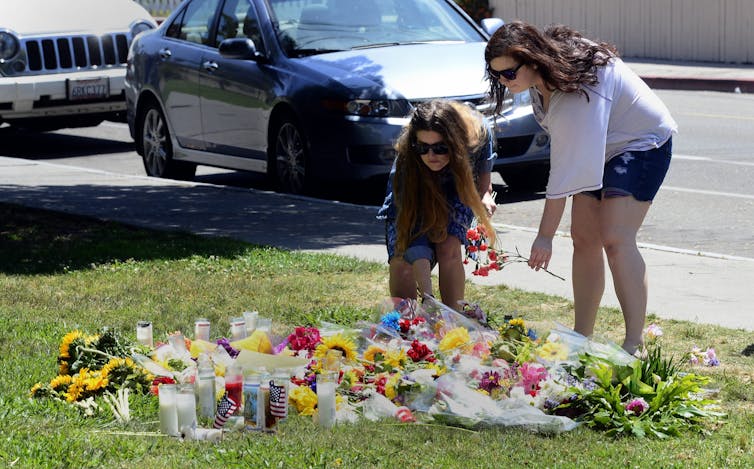So far, much of the media response to the spree killing that took place in Isla Vista, California, late last week has focused on the sole perpetrator of the attacks, 22-year-old Elliot Rodger. His rantings, where he eviscerates women and promises retribution, are available on YouTube for the world to see.
Mass shootings are becoming increasingly common in the United States and at a glance they appear to be random acts of violence. In explaining the perpetrator’s act, the media often focuses on the individual’s psychology. References are sometimes made to mental illnesses such as Asperger’s syndrome or depression, or a failure to treat these illnesses through medication.
But we continue to miss one crucial, much larger social factor: these crimes are almost always committed by men. What’s more, many of these men are well-spoken, white, educated and many are heterosexual.
Prior to the shootings, Rodger wrote in a chilling “manifesto”, since posted online, that he was going to kill all the blonde and beautiful girls because they had rejected him sexually:
Women have more power in human society than they deserve … There is no creature more evil and depraved than the human female. If I can’t have them, no one will.
Police are examining Rodger’s disturbing online messages, where he spoke about his revenge as retribution for the loneliness and pain he felt because “girls … had never been attracted to me”.
In his writings, Rodger also spoke of years of being bullied. He described himself as a dork who no-one liked and he was jealous of other guys with good looks and blond hair. He also felt physically inferior because he was shorter and less muscular than other guys.
As he became increasingly withdrawn, Rodger’s rage towards women grew:
If I can’t have you girls, I will destroy you … I’ll take great pleasure in slaughtering all of you. You will finally see that I am in truth the superior one, the true alpha male.
Dangerous and narrowing definitions of masculinity are seeping into men’s lives, impacting on how some young men compare themselves with other men and this has negative effects on how they experience life. Rodger’s manifesto read:
There were two groups of cool popular kids … they all seemed so confident and aggressive. I felt so intimidated by them and I hated them for it but I had to increase my standing with them. They were obnoxious jerks and yet somehow it was these boys who all the girls flocked to. They flock to the alpha males … to the boys who appear to have the most power and status.
But no boy or man can ever uphold all requirements of masculinity because masculinity isn’t real. In some men, hegemonic masculinity generates a sense of wronged entitlement that can lead to violence. Social theorists such as Michael Kimmel explain this as a process that makes some men routinely feel as there is no other way out other than violence. Kimmel argued this is:
…a gendered emotion, a fusion of that humiliating loss of manhood and the moral obligation and entitlement to get it back.
When feelings such as these aren’t dealt with and when no other option appears available, mass killings and often suicide can result.

Rodger clearly articulated a sense of what Kimmel calls “aggrieved entitlement”. In his videos he made numerous references to his expensive taste, glasses, clothes and car. He couldn’t understand why these powerful attributes weren’t appealing to girls.
A cumulative effect of images and ideas from advertisements, fashion, movies, peers, video games and men’s magazines creates the belief that masculinity must be important and real. Rodger writes extensively about how he became obsessed with feeling inferior. It was only when he was playing video games like Halo that he felt a sense of belonging.
Unrealistic images of idealised sexual bodies (often expressed and reinforced via social media sites such as Facebook) create further problems, generating a population of young people who potentially become identity-focused, insecure and anxious.
With rising pressures on young men to be competitive – both physically and sexually – it isn’t surprising that we are seeing increased violence and brutality by men.
Men are bombarded with sexist and altered media images that portray women as oversexualised, youthful, blonde, slender, beautiful and alluring creatures. This leaves no room for alternative interpretations. As a result, men are trained to objectify women. It can also make some men fear women because men are told by society that they should be able to attract a woman.
When men, like Rodger, don’t get the attention they believe they deserve, they experience rejection as failure. This can lead to social isolation, depression and anger. For Rodger, his sense of failure as a man resulted in increased hatred towards women.
What is alarming is that Rodger is not the only man who experienced feelings of inadequacy and powerlessness around women. Rodger has followers on YouTube and some even agree with his declarations.
Heterosexual masculinity – that a “real” man is muscular, dominant, sexy, authoritative and all women should fall at his feet – limits men’s capacity to live fulfilling and creative lives. Ideas about how a man should act leak into men’s psyches and shape what they think love, sex and romance should look like.
Some men are drowning in ideas of masculinity, leaving them anxious and angry. This stops men like Rodger from seeing women as intelligent equals. Dominant masculinity doesn’t teach men how to deal with deeper emotions, empathise or show vulnerability.
It’s time to provide better tools for young men. Let’s begin by providing healthier and alternative ideas about maleness before more innocent people are hurt or killed.

